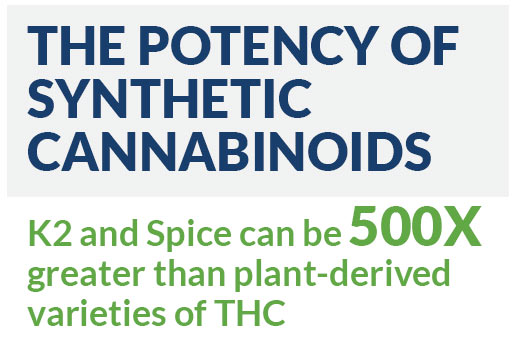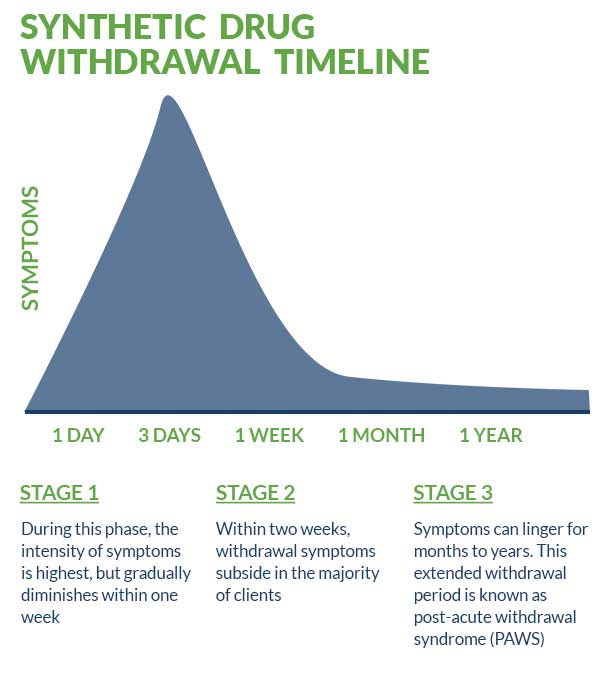Read the latest and greatest from our team
of incredible specialists.

Beach House Recovery Center » Blog » Synthetic Drugs Detox Guide: Withdrawal Symptoms & Timeline

Synthetic drugs are an increasingly popular category of addictive substances derived from chemical compounds. Illicitly manufactured by “street chemists” using technically legal chemicals, they are considered far riskier than naturally sourced drugs. Comprised of over 200 different compounds, these highly profitable “designer drugs” are easy to purchase and readily available in a variety of legal and underground markets. Users frequently have no idea what is in the drug or how the suspiciously manufactured chemicals—often mass-produced in Chinese labs—will react to each other.
Synthetic drugs replicate the effects of plant-derived drugs like marijuana and cocaine, but are known for being highly addictive and dangerously unpredictable. Due to their volatility and the unknown side effects associated with use, synthetic drugs represent an emerging public enemy, challenging authorities to crack down on their production, distribution and use.
Popular designer drugs include the following:

The dangers of synthetic drugs cannot be underestimated. Fentanyl, for example, produces a quicker, more intense high than other opiates and is often laced with illicit drugs like cocaine when sold on the street, making it more addictive. The potency of synthetic cannabinoids (“K2” and “Spice”) can be 500 times greater than plant-derived varieties of THC. In 2013-2014, there was an 80 percent increase in fentanyl-related deaths, an alarming trend echoed by the similar deadly statistics involving other designer drugs. According to the National Institute on Drug Abuse (NIDA), designer drugs are responsible for generating a new wave of criminal activity, overdoses and death.
Synthetic drugs are most often abused by physically and psychologically vulnerable 12-17 year olds and not beholden to Food and Drug Administration (FDA) required manufacturing standards. The treacherously high potency of synthetic drugs, combined with their unpredictable reactions, makes withdrawal symptoms and the withdrawal process itself difficult to establish. (Obviously, high doses of the illicit stimulant Flakka will produce a different severity and variety of symptoms than low doses of a pharmaceutically-derived opiate like fentanyl.)
Even mild recreational users risk suffering horrific withdrawal symptoms, with the majority requiring enrollment in a medically managed detox program in order to safely recover. Upon admission into an inpatient detox program, a variety of clinical tools are used to establish symptoms based on quantifiable scores. One such assessment, the Clinical Opiate Withdrawal Scale (COWS), provides a reliable method for guiding Medication-assisted treatment (MAT) and helping clinicians select appropriate therapeutic interventions. The following cluster of symptoms may appear, depending upon the variety of synthetic drug as well as frequency, intensity and duration of use:

Synthetic drug withdrawal timelines, like withdrawal symptoms, are highly variable and difficult to establish. Typically, in cases of mild to moderate use, the acute phase of withdrawal peaks and subsides very quickly, within three to four days. During this phase, the intensity of symptoms is highest, but gradually diminishes within one week. Within two weeks, withdrawal symptoms subside in the majority of clients; however, they can linger for months and even years. This extended withdrawal period is known as post-acute withdrawal syndrome (PAWS) and may be severe enough that ongoing medication management and formal treatment are required in order to avoid relapse and other serious, debilitating consequences.
The half-life and extended life of various synthetic drugs are too variable to quantify, but tend to follow similar guidelines compared to other potent opiates. Although urine, blood and saliva samples may detect the substances within hours or days following use, hair samples are usually detectable for up to 90 days afterwards.
Inpatient treatment is a highly popular, evidence-based protocol in which clients live at a designated facility— usually for a month, but in some cases, as many as three. During their stay, clients receive intensive medical supervision and ongoing medication management by a team of highly qualified professionals in addition to psychotherapy by licensed clinicians. Widely considered the industry “gold-standard” for effective treatment, intensive inpatient is an excellent choice for synthetic drug users—all of whom benefit from the 24/7 staff monitoring, heightened security, enhanced camaraderie and impressive ancillary services and benefits.
Medication-assisted treatment (MAT) is an integral aspect of inpatient treatment that involves carefully administered doses of Food and Drug Administration (FDA) approved medications in tandem with psychotherapy. Cognitive behavioral therapy (CBT), motivational interviewing (MI), trauma-informed therapy, family therapy, and dialectical behavioral therapy (DBT) are all popular, evidence-based therapies included in the scope of MAT.
Depending upon the severity and type of synthetic drug abused—medications like Suboxone, Subutex and Vivitrol may be used to reduce the intensity of cravings and manage withdrawal symptoms. Antipsychotics are also used to treat cases of acute psychosis triggered by withdrawal from psychoactive “Spice,” a phenomenon known as “spiceophrenia.” In cases where extreme anxiety is the primary symptom, benzodiazepines “benzos” may be included in the treatment regimen.
A broad range of anxiety, depression and trauma-related disorders are known to be precipitating factors involved in synthetic drug addiction— and addiction in general. Treating these co-existing disorders is a critical aspect of inpatient treatment and supplemental medications include:
Outpatient facilities allow clients to live at home while receiving treatment services, and provide the primary advantage of flexibility for clients whose personal and/or professional schedules require it. Offered in varying levels, certain facilities require a minimum commitment of five days per week while others require only one to two days per week, often during evening sessions. Generally cheaper than inpatient treatment, outpatient treatment is also considered less effective.
“Cold turkey” refers to abrupt discontinuation of use. Quitting any medication cold turkey is never recommended and may lead to a frightening, unpredictable acceleration and intensification of symptoms called “precipitated withdrawal.” Preventing precipitated withdrawal is the primary goal of medically supervised detox. “Tapering” describes a practice that involves administering carefully controlled doses of a drug to help wean the user off. Tapering has been deemed unnecessarily risky, with mounting evidence supporting the efficacy of stabilizing medications like Suboxone, Subutex and Vivitrol— especially when treating highly potent synthetic drugs like fentanyl.
For the majority of clients, the decision to enroll in treatment will depend upon insurance coverage, affordability, location and reputation. Reputable facilities will be able to verify insurance benefits prior to enrollment. In cases where partial, if not total, coverage is denied, additional options (grants, scholarships or affordable payment plans) may be available.
Successful completion of inpatient detox is only the beginning of the recovery journey. A comprehensive relapse prevention plan should include the following aftercare support services—all of which are empirically-proven to increase favorable treatment outcomes:
For more about synthetic drug detox and recovery, check out these related articles:
International Journal of Neuropsychopharmacology. Spice/K2 drugs—more than innocent substitutes for marijuana. March, 2014.
National Institute on Drug Abuse (NIDA). Synthetic Cannabinoids. Feb, 2018.
Pharmacy and Therapeutics. Synthetic Cathinones (‘Bath Salts’). Oct, 2012.
Policing and Society. Networks and Meta-regulation: Strategies Aimed at Governing Illicit Synthetic Drugs. Nov, 2006.
Frontiers in Psychiatry. Synthetic Cathinone and Cannabinoid Designer Drugs Pose a Major Risk for Public Health. August, 2017.
The New England Journal of Medicine. “Bath Salts” Intoxication. September, 2011.
Science. Underground labs in China are devising potent new opiates faster than authorities can respond. March, 2017.
Whether you’re researching for yourself or a loved one, Beach House can help. We understand that this is a serious time in your life and that the treatment center you choose matters. We want you to feel comfortable and empowered to make the right decision for yourself, a friend, or a family member. This is why a counselor is waiting and available to answer your questions and help put your mind at ease regarding the next steps. Many of the staff at Beach House have walked in your shoes. If you feel you’re ready or want more information about how to help a loved one, we can help today. You can also learn why we are voted the #1 rehab for addiction treatment in Florida.
We accept most major insurance plans and can verify your benefits quickly and confidentially.
We’re committed to helping you access the care you need, our admissions counselors can guide you through your coverage options and available resources.





"*" indicates required fields